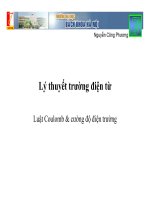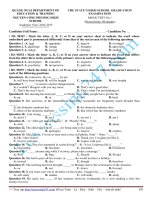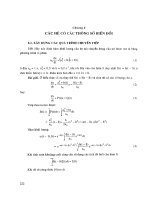Lecture Engineering electromagnetics: Vector analysis - Nguyễn Công Phương
Bạn đang xem bản rút gọn của tài liệu. Xem và tải ngay bản đầy đủ của tài liệu tại đây (239.56 KB, 38 trang )
Nguyễn Công Phương
Engineering Electromagnetics
Contents
I. Introduction
II. Vector Analysis
III. Coulomb’s Law & Electric Field Intensity
IV. Electric Flux Density, Gauss’ Law & Divergence
V. Energy & Potential
VI. Current & Conductors
VII. Dielectrics & Capacitance
VIII.Poisson’s & Laplace’s Equations
IX. The Steady Magnetic Field
X. Magnetic Forces & Inductance
XI. Time – Varying Fields & Maxwell’s Equations
XII. The Uniform Plane Wave
XIII.Plane Wave Reflection & Dispersion
XIV.Guided Waves & Radiation
Engineering Electromagnetics - sites.google.com/site/ncpdhbkhn
2
Introduction (1)
• The study of charges (at rest or in motion)
• Fundamental to electrical engineering
• Why study?
–
–
–
–
Electromagnetic Compatibilty
High Frequency Circuits
Communications
etc.
• Applications: communication technology, computer technology,
antenna technology, biomedical applications, military defense, etc
• Ampere, Faraday, Gauss, Lenz, Coulomb, Maxwell, …
Engineering Electromagnetics - sites.google.com/site/ncpdhbkhn
3
Introduction (2)
Electromagnetics
Electrostatics
∂q
=0
∂t
Magnetostatics
Electromagnetic Waves
∂I
=0
∂t
∂I
≠0
∂t
Engineering Electromagnetics - sites.google.com/site/ncpdhbkhn
4
Introduction (3)
• W. H. Hayt, J. A. Buck. Engineering
Electromagnetics. McGraw-Hill, 2007
• E. J. Rothwell, M. J. Cloud. Electromagnetics.
CRC Press, 2001
• N. B. Thành, N. T. Quân, L. V. Bảng. Cơ sở lý
thuyết trường điện từ. NXB Đại học & trung học
chuyên nghiệp, 1970
• />Engineering Electromagnetics - sites.google.com/site/ncpdhbkhn
5
Contents
I. Introduction
II. Vector Analysis
III. Coulomb’s Law & Electric Field Intensity
IV. Electric Flux Density, Gauss’ Law & Divergence
V. Energy & Potential
VI. Current & Conductors
VII. Dielectrics & Capacitance
VIII.Poisson’s & Laplace’s Equations
IX. The Steady Magnetic Field
X. Magnetic Forces & Inductance
XI. Time – Varying Fields & Maxwell’s Equations
XII. The Uniform Plane Wave
XIII.Plane Wave Reflection & Dispersion
XIV.Guided Waves & Radiation
Engineering Electromagnetics - sites.google.com/site/ncpdhbkhn
6
Vector Analysis
1.
2.
3.
4.
5.
Scalars & Vectors
The Rectangular Coordinate System
The Dot Product & The Cross Product
The Circular Cylindrical Coordinate System
The Spherical Coordinate System
Engineering Electromagnetics - sites.google.com/site/ncpdhbkhn
7
Scalars & Vectors
• Scalar: refers to a quantity whose value may be
represented by a single (positive/negative) real number
• Ex.: distance, time, temperature, mass, …
• Scalars are in italic type, e.g. t, m, E,…
• Vector: refers to a quantity whose value may be
represented by a magnitude and a direction in space (2D,
3D, nD)
• Ex.: force, velocity, acceleration, …
• Vectors are in bold type, e.g. A
• A may be written as A
Engineering Electromagnetics - sites.google.com/site/ncpdhbkhn
8
Vector Analysis
1.
2.
3.
4.
5.
Scalars & Vectors
The Rectangular Coordinate System
The Dot Product & The Cross Product
The Circular Cylindrical Coordinate System
The Spherical Coordinate System
Engineering Electromagnetics - sites.google.com/site/ncpdhbkhn
9
The Rectangular Coordinate System (1)
z
0
y
x
Engineering Electromagnetics - sites.google.com/site/ncpdhbkhn
10
The Rectangular Coordinate System (2)
z
z = za plane
x = xa plane
0
y
x
y = ya plane
a (xa, ya, za)
Engineering Electromagnetics - sites.google.com/site/ncpdhbkhn
11
The Rectangular Coordinate System (3)
z
dS = dxdyaz
dy
dS = dydzax
0
P
dz
dV
y
dx
x
dS = dxdzay
dV = dxdydz
Engineering Electromagnetics - sites.google.com/site/ncpdhbkhn
12
The Rectangular Coordinate System (4)
z
z
r
az
ar
y
0
ax
x
y
ay
x
r=x+y+z
→ r = xax + yay + zaz = rxax + ryay + rzaz
x = xax; y = yay; z = zaz
r = rx2 + ry2 + rz2
ar =
r
rx2 + ry2 + rz2
Engineering Electromagnetics - sites.google.com/site/ncpdhbkhn
=
13
r
r
Ex.
The Rectangular Coordinate System (5)
Given a vector V = 5ax – 2ay + 4az, find:
a) Its components?
b) Its magnitude?
c) Its unit vector ?
Engineering Electromagnetics - sites.google.com/site/ncpdhbkhn
14
Vector Analysis
1.
2.
3.
4.
5.
Scalars & Vectors
The Rectangular Coordinate System
The Dot Product & The Cross Product
The Circular Cylindrical Coordinate System
The Spherical Coordinate System
Engineering Electromagnetics - sites.google.com/site/ncpdhbkhn
15
The Dot Product (1)
• A·B = |A||B|cosθAB
– |A|: magnitude of A
– |B|: magnitude of B
– θAB: smaller angle between A & B
• A·B = B·A
• A·B = AxBx + AyBy + AzBz
Engineering Electromagnetics - sites.google.com/site/ncpdhbkhn
16
The Dot Product (2)
B
θBa
a
B
θBa
a
B·a
(B·a)a
The scalar component
of B in the direction of
the unit vector a
The vector component
of B in the direction of
the unit vector a
Ex.: Bx = B·ax
Ex.: Bxax = (B·ax)ax
Engineering Electromagnetics - sites.google.com/site/ncpdhbkhn
17
Ex.
The Dot Product (3)
Consider the vector field G = zax – 2xay + 3yaz and the point Q(4, 3, 2). Find:
a) G at Q ?
b) The scalar component of G at Q in the direction of aN = ⅓(ax + 2ay – 2az) ?
c) The vector component of G at Q in the direction of aN ?
d) The angle between G(rQ) & aN ?
a) G(rQ ) = 2a x − 2 × 4a y + 3 × 3a z = 2a x − 8a y + 9a z
1
b) G • a N = (2a x − 8a y + 9a z ) • (a x + 2a y − 2a z )
3
1
= (2 × 1 − 8 × 2 − 9 × 2) = −10.67
3
G
θ
aN
G·aN
Engineering Electromagnetics - sites.google.com/site/ncpdhbkhn
18
The Dot Product (4)
Ex.
Consider the vector field G = zax – 2xay + 3yaz and the point Q(4, 3, 2). Find:
a) G at Q ?
b) The scalar component of G at Q in the direction of aN = ⅓(ax + 2ay – 2az) ?
c) The vector component of G at Q in the direction of aN ?
d) The angle between G(rQ) & aN ?
a) G(rQ ) = 2a x − 2 × 4a y + 3 × 3a z = 2a x − 8a y + 9a z
b) G • a N = −10.67
1
c) ( G • a N )a N = ( −10.67) (a x + 2a y − 2a z )
3
= −3.55a x − 7.11a y + 7.11a z
G
θ
aN
(B·aN)aN
Engineering Electromagnetics - sites.google.com/site/ncpdhbkhn
19
The Dot Product (5)
Ex.
Consider the vector field G = zax – 2xay + 3yaz and the point Q(4, 3, 2). Find:
a) G at Q ?
b) The scalar component of G at Q in the direction of aN = ⅓(ax + 2ay – 2az) ?
c) The vector component of G at Q in the direction of aN ?
d) The angle between G(rQ) & aN ?
a) G(rQ ) = 2a x − 2 × 4a y + 3 × 3a z = 2a x − 8a y + 9a z
b) G • a N = −10.67
c) ( G • a N )a N = −3.55a x − 7.11a y + 7.11a z
d) G • a N = Ga N cosθ = −10.67
→ 22 + 82 + 92 × 1 × cos θ = −10.67
→ θ = 151o
Engineering Electromagnetics - sites.google.com/site/ncpdhbkhn
20
The Cross Product (1)
• A B = aN|A||B|sinθAB
– aN: normal (unit) vector
• B A = – (A B)
A
ax
A × B = Ax
ay
Ay
az
Az
Bx
By
Bz
θAB
B
A B
ax, ay, az : unit vectors of x, y, z axes
Engineering Electromagnetics - sites.google.com/site/ncpdhbkhn
21
Ex. 1
The Cross Product (2)
Given A = ax – 2ay + 3az and B = –4ax + 5ay – 6az . Find their cross product ?
ax
A × B = Ax
ay
Ay
Bx
By
= ax
ax a y az
az
Az = 1 −2 3
−4 5 −6
Bz
−2
3
5
−6
− ay
1
3
−4 −6
+ az
1
−2
−4
5
= −3a x − 6a y − 3a z
Engineering Electromagnetics - sites.google.com/site/ncpdhbkhn
22
Ex. 2
The Cross Product (3)
Given A = ax – 2ay + 3az and B = –4ax + 5ay – 6az . Find the angle between A & B?
Method 1:
A × B = a N A B sin θ
A×B
→ A × B = A B sin θ → sin θ =
A B
A × B = −3a x − 6a y − 3a z → A × B = 32 + 62 + 32 = 7.35
A = 12 + 22 + 32 = 3.74
B = 4 2 + 52 + 62 = 8.75
7.35
→ sin θ =
= 0.22 → θ = asin(0.22) = 12.9o
3.74 × 8.75
Engineering Electromagnetics - sites.google.com/site/ncpdhbkhn
23
The Cross Product (4)
Ex. 2
Given A = ax – 2ay + 3az and B = –4ax + 5ay – 6az . Find the angle between A & B?
Method 2:
A • B = A B cos θ → cos θ =
A•B
A B
A • B = 1( −4) − 2(5) + 3( −6) = −32
A = 12 + 22 + 32 = 3.74
B = 4 2 + 52 + 62 = 8.75
−32
→ cos θ =
= −0.97 → θ = a cos( −0.97) = 12.9o
3.74 × 8.75
Engineering Electromagnetics - sites.google.com/site/ncpdhbkhn
24
Ex. 3
The Cross Product (5)
Given A = ax – 2ay + 3az, B = –4ax + 5ay – 6az, and C = ax – ay + az. Find:
a) A ± B, B ± C, C ± A
b) A.B, B.C, C.A
c) A B, B C, C A
d) (A B).C, A.(B C)
e) What is the angle between B and C A?
Engineering Electromagnetics - sites.google.com/site/ncpdhbkhn
25









